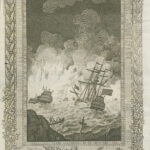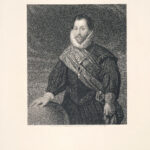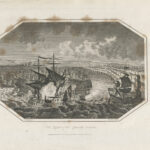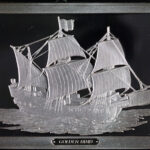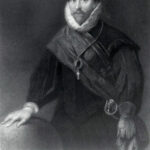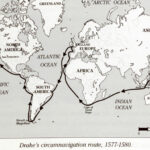Francis Drake
Explorer
Age of Discovery
Quick Facts:
He effectively ended Spanish dominance over the seas and the New World, allowing England to become a global empire.
Introduction
Francis Drake’s (later called Sir Francis Drake) adventurous life was filled with many accomplishments. He played a major role in the destruction and defeat of the mighty Spanish Armada. This helped England to create a great empire in the New World. He also became the first Englishman to circumnavigate the globe. During his world voyage, he explored much of the northwestern part of the modern United States. His strong dislike for the Spanish motivated him to destroy and loot as many Spanish vessels as possible. Some would call Sir Francis Drake a pirate, others would call him a privateer. But to the English, most saw him a hero.
Biography
Early Life
Francis Drake was born at Tavistock, in Devonshire, England around 1540, although the exact date is not certain. He was the oldest of 12 boys.1 His father, Edmund Drake, was a shearman. This is someone who used a skilled technique to soften cloth.2 They lived on a large farm, and his father was also able to make money as a farmer. Very little is known or certain about his childhood and education. In the early 1550s, young Francis began working as an apprentice on a trading ship. While here, Drake was taught several skills that a sailor would have, including how to sail and how to navigate, and was also provided food and shelter. In 1567, he went to work for his cousin John Hawkins who was a slave trader. They would travel to Africa, where they would capture and chain Africans, sail across the Atlantic, and sell the African people to European colonists. Drake joined him on his trading trips to the New World.
At this time, much of the Caribbean islands, South America, and Mexico were controlled by the Spanish empire. England and Spain were often at war with each other, and as such, the Spanish banned trading with the English in their colonies. But this did not stop people like Hawkins and Drake. But Drake and Hawkins often encountered problems. In October 1567, Hawkins and Drake arrived at San Juan de Ulúa on the Mexican coast ready to trade.3 They had six ships including the Minion – captained by Hawkins – and the Judith – captained by Drake. It was not long before the Spanish attacked the English fleet. Four of the ships were destroyed, but the Judith survived. Hawkins also managed to escape. This battle would create a deep hatred for the Spanish in Drake. After his return to England, Drake happily accepted a position by Queen Elizabeth I in 1570 to become a privateer. A privateer is similar to a pirate, but unlike pirates who raid for their personal use, privateers are usually hired and paid. Drake spent the next several years commanding several vessels raiding and destroying Spanish fleets. Drake became a hero to the English people. But once England and Spain had reached a temporary peace, Drake’s privateering services were not needed. But peace did not last long, and Drake was called on again once more.
Voyages
Principal Voyage
In 1577, war broke out again between England and Spain. Elizabeth I gave Drake command of an expedition to set up English trading posts in the Pacific.4 But Drake also had his own plans. He planned to continue raiding Spanish fleets, and attacking Spanish settlements in South America. Drake and his fleet left from the port of Plymouth in England on December 13, 1577. He had five ships: The Elizabeth, Swan, Christopher, Marigold, and the Pelican which Drake commanded. He sailed across the Atlantic to Brazil, then south down the coast to Argentina to an area called Patagonia. While here, at Port St. Julian, a firefight between the English and Natives broke out, killing several men on both sides. By August 20, 1578, Drake and his fleet entered the Strait of Magellan, and crossed into the Pacific Ocean.5 It had taken Ferdinand Magellan a month to cross through the Strait; it only took Drake 16 days.6 It is around this time that Drake renamed his ship Golden Hind. The fleet then sailed north up the west coast of South America.
Drake raided several Spanish ships and outposts along Chile and Peru. After capturing and destroying several Spanish vessels, and taking their riches, Drake and his crew continued onward. The other ships had either turned back for home or had been damaged and lost at sea.7 After passing through the Strait of Magellan, Drake began making his way up what would become the west coast of the United States. He made it as far as present day Vancouver Island before heading back south down the coast. He stopped briefly near modern day Coos Bay, Oregon, and then continued on. He charted much of the unknown west coast of North America. In June 1579, Drake landed at Point Reyes, near present day San Francisco, California, and claimed the land for Queen Elizabeth and England.8 Here, the English interacted with the friendly Miwok natives for several weeks. The Golden Hind left the area on July 23, 1579, and headed for home.9 They sailed across the Pacific Ocean. For almost 2 months they saw no land. They eventually reached the Molucca Islands (present day Indonesia). After a brief stay, they sailed again, rounding the southern tip of Africa, and headed north to England. After almost three years sailing around the world, the Golden Hind reached England on September 26, 1580. Although he was the second person to circumnavigate the world, he was the first Englishman to do it.
Subsequent Voyages
When Drake returned to England, he brought with him much treasure. Queen Elizabeth rewarded his success. In 1581, the Queen knighted him. So he was now Sir Francis Drake. He became mayor of Plymouth for the next four years.10 When hostilities between Spain and England worsened, Drake once again went to sea. In 1585, he sailed towards Spain where he attacked several ships in their fleet, then headed across the Atlantic. He then attacked Spanish fleets in present day Colombia and Dominican Republic. On histheir way back to England, Drake stopped to resupply the struggling colony at Roanoke Island (present-day North Carolina), founded by Sir Walter Raleigh. The colonists there were so miserable that they decided to abandon the colony and return to England with Drake.
Later Years and Death
By 1587, Drake once more left England to attack the Spanish. He destroyed a fleet in Portugal which delayed a Spanish attack on England. After a few more encounters with the Spanish, Drake went back to Plymouth for several years. His next expedition would be less fortunate. Drake went out to sea again in 1595 with John Hawkins. They sailed to the Caribbean, where Drake soon got sick. He got infected with dysentery, a disease that infects the intestines. Sir Francis Drake died on his ship from this illness on January 28, 1596 off the coast of Panama.11
Legacy
Sir Francis Drake’s accomplishments cemented English dominance at sea. The Spanish Armada never fully recovered from Drake’s victories. This loss weakened their grip in the New World, and allowed the English to establish themselves as a great empire. In addition to his military achievements, he was a famed explorer who claimed part of the west coast of North America for England. He also rescued many of the settlers from the doomed Roanoke settlement. Drakes Bay near San Francisco bears the name of the great English explorer who helped claim these lands for the English.
Images
- One of Drake’s victories over the Spanish Armada in 1588. The Mariners’ Museum 1936.0520.000001
- Portrait of Sir Francis Drake, engraved by W. Holl. The Mariners’ Museum 1936.0605.000001
- 1804 print showing Drake’s English victory over the Spanish Armada’s 132 ships, 33,000 soldiers and crews sent by Phillip II of Spain. The Mariners’ Museum 1968.0088.000001
- Silver ingot of Drake’s flagship “Golden Hind” on his voyage around the globe. The Mariners’ Museum 1974.0001.000017
- Back side of silver ingot with description of the ship, and its role in Drake’s circumnavigation. The Mariners’ Museum Silver ingot of Drake’s flagship “Golden Hind.” The Mariners’ Museum 1974.0001.000017
- Image showing a portrait of Sir Francis Drake (ca. 1540 – 1596), first Englishman to sail around the globe. The Mariners’ Museum G175 B56 2003
- Map showing the route Francis Drake took on his circumnavigation around the world. The Mariners’ Museum G175 B56 2003
- “Golden Hind” was Drake’s ship on his famous voyage around the world. The Mariners’ Museum 19330511.000001
Endnotes
- Richard E. Bohlander, ed., World Explorers and Discoverers (New York: MacMillan Publishing Company, 1992), 155.
- Lynn Hoogenboom, Sir Francis Drake: A Primary Source Biography (New York: The Rosen Publishing Group, Inc., 2006), 4.
- Don Nardo, Sir Francis Drake EBook (Hockessin: Mitchell Lane Publishers Inc., 2016), 5.
- Bohlander, World Explorers and Discoverers, 156.
- Daniel B. Baker, ed., Explorers and Discoverers of the World (Detroit: Gale Research, Inc., 1993), 207
- Bohlander, World Explorers and Discoverers, 157.
- Britannica Educational Publishing, Biographies of the New World: Leif Eriksson, Henry Hudson, Charles Darwin, and More, ed. Michael Anderson (New York: Britannica Educational Publishing, 2013), 67.
- Rand Richards, Historic San Francisco: A Concise History and Guide (San Francisco: Heritage House Publishers, 2007), 16.
- Bohlander, World Explorers and Discoverers, 157.
- Bohlander, World Explorers and Discoverers, 158.
- Baker, Explorers and Discoverers of the World, 208.


